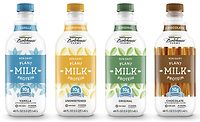It was only a matter of time before hot and spicy ingredients made the transition from food to beverages, according to Lisa Demme, marketing director for Fona International, Geneva, Ill. Now, there’s no slowing the flavor profiles down, suppliers say.
Spicy beverages have even begun appearing on menus of fast-food restaurants, such as Sonic, which offers a Jalapeno Chocolate Shake, points out Judson McLester, executive chef and ingredient sales manager for Tabasco at McIlhenny Co., Avery Island, La.
“When spicy beverage combinations make it onto fast-food menu offerings, I would say that [means] the category has nearly exploded,” he says.
Spicy ingredients also have made an impact on beverage categories including coffee, beer, coconut water, smoothies and spirits. In the coffee category, chili and chocolate combinations are becoming more common as Mexican or Aztec coffee drinks gain in popularity as after-dinner options, Fona’s Demme says. Craft brewers also are experimenting with chilis in their seasonal and limited-edition beers, she adds. In particular, chili pepper flavors pair best with stout beers, notes Bridget Schigoda, consumer insights manager for Sensient Flavors, Hoffman Estates, Ill.
“The natural creaminess of a stout can dissipate the pepper flavor quickly on the consumer’s palate, giving the consumer a spike of heat that does not linger,” she explains.
Some coconut water formulations are even putting a twist on their offerings by using chili extracts, Schigoda adds. Plus, fruit-and-vegetable-juice smoothies with Tabasco pepper sauce or cayenne pepper now are appearing in grocery stores and foodservice locations like Smoothie King, McIlhenny Co.’s McLester says.
In the spirits category, spicy ingredients are particularly trendy across the rum, bourbon and whiskey segments, Fona’s Demme adds. Within these particular spirits segments, Demme notes that cinnamon is the most common spice used. Tequilas and vodkas infused with pepper and chili flavors also have begun to hit shelves, she says.
“We see the majority of heat and spice experimentation happening across alcoholic beverage categories and among mixologists in their development of signature cocktails, but this is not uncommon as flavor trends often start in alcoholic beverages and then move to non-alcoholic categories,” Demme says.
Dropping names
Regardless of the beverage category, it’s clear that spicy flavors are making their way across the beverage industry. As their usage expands and U.S. consumers become more accepting of spicy flavor profiles, beverage-makers are honing in on specific chili varietals in their formulations, Demme notes.
“No longer is the descriptor that precedes the named market product simply ‘spicy,’ but rather it is a callout of a specific type of pepper, like chipotle, habanero, jalapeño or ancho, or it is a reference to a hot sauce or spread paste like Southeast-Asian-influenced sriracha, North African harissa or Japanese-inspired wasabi,” she explains.
In accordance with this trend, Sensient Flavors recently launched a full collection of chili pepper flavors for savory applications that could be transferred to beverage applications. The collection includes guajillo, a woody-piney flavored pepper with tart berry notes and a slightly smoky undertone; jalapeño, an earthy, citrus-forward flavor with a burning sensation; pickled jalapeño, a distinctly acidic, green vegetable flavor with a warm, burning acidic sensation; chipotle, a smoky and sweet flavor with tobacco and chocolate undertones and a deep, rounded heat; aji amarillo, a bright, fruity flavor with a subtle, full-body heat; and peri-peri, a clean and slightly sweet flavor with undertones of dry hay, Schigoda explains. The company also released a line of Chili Blends, including a Red Sriracha Blend, Indian Curry Blend, Thai Arbol Chile Blend, All-American Hot Sauce Blend, and Moroccan Harissa Blend, among others.
Best known for its Tabasco hot sauce, McIlhenny Co. also offers a variety of spicy ingredients for beverage applications. Its lineup includes Original Red, Chipotle, Green, Buffalo, Habanero and Garlic Pepper.
“Consumers are demanding something other than the old guard of beverage offerings, and spicy has stepped up to offer a unique and exhilarating experience,” McLester says.
Consumer support
In general, consumers are seeking elevated sensory experiences, which in turn is supporting the success of spicy beverages, Sensient Flavors’ Schigoda says.
“As complex and multifaceted individuals that crave products that cut through the clutter, consumers gravitate toward products that leave a lasting impress-ion,” she says. “By introducing an unexpected twist, like cayenne lemonade or mango jalapeño water, beverage manufacturers can deliver on this trend and delight their consumers.”
Additionally, many consumers take an interest in spicy foods and beverages because they want to add some excitement to their consumption experience, Schigoda notes.
“Consumers are looking to try the most daring of hot and spicy ingredients so they can be part of a community that finds excitement in trying foods and beverages that are so hot they make you cry,” she explains.
In particular, the millennial and Hispanic demographic groups are boosting the ingredients’ popularity in beverages, Fona’s Demme notes.
“Millennials in particular lead the charge as ‘heat seekers’ and are among the most adventurous age group, having been widely exposed to both Latin and Asian cuisines that ‘turn up the heat,’” Demme says.
The U.S. Hispanic population also reinforces the popularity of hot and spicy ingredients and helps to bring them mainstream, she adds. Citing 2013 data from the U.S. Census Bureau, approximately 17 percent of the U.S. population is Hispanic, she notes. Thus, both retailers and foodservice operators are trying to appeal to this growing consumer base with appropriate product offerings, she adds.
Spicy combinations
As interest in spicy ingredients continues to increase, other flavor profiles are adding to its appeal. For example, sour, sweet and tangy flavor profiles pair well with hot and spicy ingredients, McLester says.
“Sour items benefit from an acidic-based heat product,” he explains. “It allows the flavor to meld into the overall taste instead of remaining a separate, detectable element. This, in turn, provides a pleasant sensation of warmth and craving.”
When it comes to sweet-and-spicy flavor comb-inations, Thai cuisine “knocks it out of the park” because multiple sweet flavor perceptions are being countered immediately by different heats, he says. “With sweet items, it is important to utilize this strategy to keep the developed product interesting and not overly hot or sweet,” he notes.
Fruit flavors also fit into the “sweet” flavor range and pair well with spicy flavors, Fona’s Demme notes. For instance, tropical flavors such as mango or pineapple pair well with chilies and other hot and spicy flavors, she says. Plus, combining citrus flavors like lime with spice offers the potential to be distinct and refreshing, she adds.
Finally, tangy flavors amalgamate sweet with a little bit of sour. Therefore, when they are combined with spicy flavors, formulators should use sweet and heat flavor combinations but at a muted level, McIlhenny Co.’s McLester says. “The diminished rate of use allows the heat to settle into the overall flavor profile and provide a pleasing, ‘craveable’ sensation,” he says.
Additionally, adding spicy flavors like cinnamon or chili peppers to chocolate can bring complexity to the classic chocolate profile, Fona’s Demme says. In contrast, cooling flavors like mint and cucumber can blend well with spicy flavors by alleviating some of the negative associations with an overly spicy flavor profile and creating an invigorating or refreshing combination, Sensient Flavors’ Schigoda adds.






